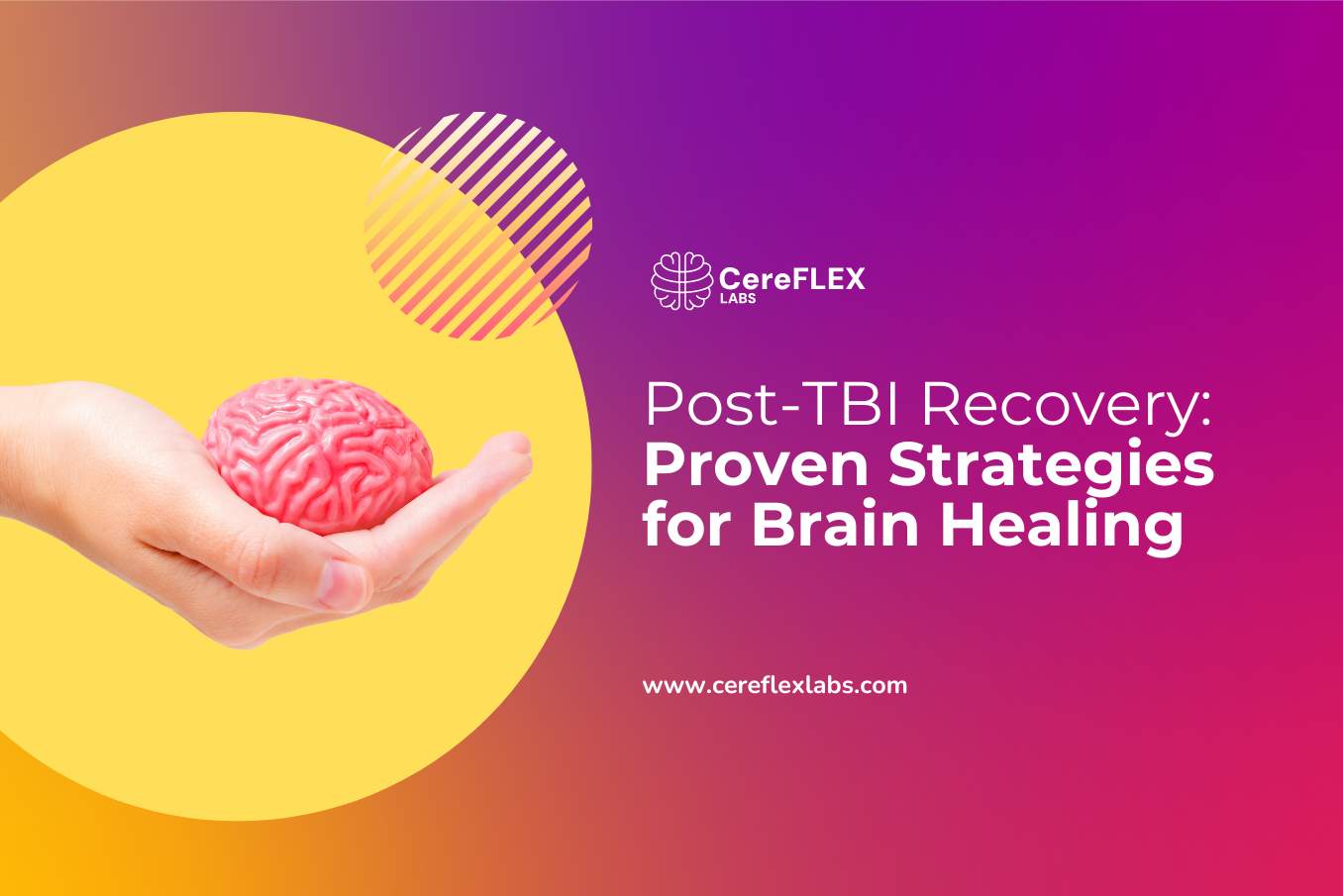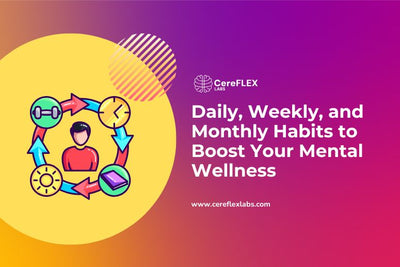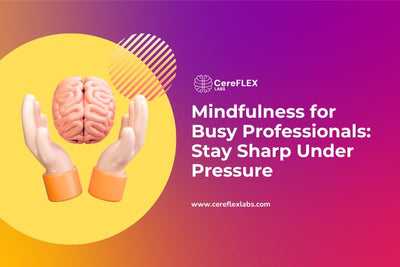Recovering from a brain injury might seem like an uphill battle, but even the smallest steps can lead to incredible progress. Let’s talk about how you can make that happen. This is your guide to navigating the twists and turns of recovery, armed with science-backed tips and a dash of encouragement.
Whether it’s overcoming cognitive fog, healing after a concussion, or supporting a loved one through their journey, we are here to simplify the complex and give you actionable steps you can trust.
Together, we’ll tackle everything from understanding the science of brain health to debunking myths and embracing holistic solutions like CereFLEX Labs—a supplement designed to enhance cognitive function and memory.
Here is the Quick Answer |
|
Recovering from a Traumatic Brain Injury (TBI) takes time, but progress is possible with the right support. Focus on neuroplasticity, proper nutrition, consistent routines, and therapies like cognitive training and mindfulness. Supplements like CereFLEX Labs can help fill nutritional gaps and support brain healing. Small steps each day can lead to lasting recovery. |
Understanding TBI Recovery: A Journey of Resilience
When it comes to recovering from a Traumatic Brain Injury (TBI), patience isn’t just a virtue—it’s a necessity. But what’s really going on inside your head after a TBI? Let’s break it down.
What exactly happens to the brain after a TBI?
Think of your brain like a bustling city. A TBI is like a natural disaster disrupting the flow of traffic, damaging infrastructure, and leaving areas in need of repair. Here are some of the key changes that occur:
Inflammation
It’s the brain’s version of calling in emergency services. This natural healing response helps clear the damage but can turn destructive if it sticks around too long.
Oxidative Stress
Ever seen rust form on metal? That’s oxidative stress in action, but in your brain. A TBI can tip the balance between harmful free radicals and protective antioxidants, damaging brain cells and slowing recovery.
Hormonal Imbalances
Your pituitary gland, often impacted by TBIs, might struggle to regulate hormones. This can show up as fatigue, mood swings, or trouble focusing—not exactly what you need when trying to heal.
Strategies Matter!
Did you know over 5 million Americans live with TBI-related disabilities?1 Recovery isn’t just about waiting; it’s about actively supporting your brain as it rebuilds. Addressing issues like glucose metabolism disruptions can create the foundation for long-term healing.
Meet CereFLEX: Your Brain's Best Sidekick
CereFLEX Labs is like that trusty tool you didn’t know you needed. Designed to address the unique needs of brain health, this supplement simplifies the process by enhancing memory, cognition, peripheral circulation, and supporting the fight against oxidative damage. It’s a game-changer for anyone looking to support their brain health and move forward.
The Science of Brain Healing
Healing from a TBI isn’t magic—it’s science and effort working hand in hand. The brain has an incredible ability to adapt and recover, but it needs a little help from you.
Neuroplasticity: Your Brain’s Superpower
Imagine your brain as a city rerouting traffic after an accident. Neuroplasticity is the process of building new roads and connections to get things moving again. Activities like solving puzzles, learning a new language, or picking up an instrument can supercharge this process. Plus, research shows physical exercise can boost BDNF—a protein that helps create these neural pathways.
Metabolic Recovery: Fuel for the Journey
After a TBI, your brain’s energy demands skyrocket. Think of it as a car running low on fuel—it can’t perform without the right support. Supplement protocols can act as a high-quality fuel, restoring balance and helping your brain meet its energy needs efficiently.
Myths vs. Facts About TBI Recovery
TBI recovery is a journey—one often filled with challenges, progress, and yes, misconceptions. Have you ever heard someone say, “If you don’t recover in six months, it’s over”? If that stopped you in your tracks, you’re not alone. But here’s the thing: it’s simply not true. Let’s tackle this and other common myths that could hold you back.
Myth #1: Recovery Stops After Six Months
- The Myth: Progress grinds to a halt after six months.
- The Truth: Recovery doesn’t come with an expiration date. Neuroplasticity allows your brain to adapt and grow for years. Therapies, structured routines, and supplement protocols can help you continue making strides well beyond the six-month mark.
Myth #2: Rest is the Only Cure
- The Myth: Complete rest is the only way to heal.
- The Truth: While rest is crucial early on, active recovery—like cognitive exercises and light physical activity—is essential for rebuilding brain connections. Think of it like strengthening a muscle; you need to use it to make it stronger.
Myth #3: TBI Affects Only Physical Abilities
- The Myth: Recovery is all about motor skills.
- The Truth: Healing is a three-part process: physical, cognitive, and emotional. Addressing all three ensures a well-rounded recovery.
Myth #4: Supplements Are a Quick Fix
-
The Myth: Supplements alone can resolve Traumatic brain injury symptoms.
- The Fact: Think of supplements as part of a team effort. Just like an orchestra needs more than a solo violinist, your recovery plan needs multiple elements working together. Supplements like CereFLEX Labs can be powerful tools, especially when paired with nutrient-rich meals, therapy, and consistent routines.
Breaking Free from Myths
Believing in these myths can keep you from reaching your full potential. The truth? Your recovery journey is unique, and progress is possible well beyond the timelines or limits others might suggest.
Ready to rewrite your recovery story? Stay curious, trust the process, and seek support—your brain is capable of incredible things. Start with small steps and keep building—you’ve got this!
Proven Strategies for TBI Recovery
Recovering from a TBI involves more than just time—it’s about taking deliberate steps to support your brain’s healing process. Let’s explore some science-backed strategies to help you move forward with confidence.

1. Nutritional Support: Feeding the Brain
Your brain is like a high-performance engine—it runs best on premium fuel. Nourishing your brain with the right nutrients can kickstart healing and keep things running smoothly. Here’s what to focus on:
Essential Nutrients for Brain Recovery
- Omega-3 Fatty Acids: Found in salmon, walnuts, and flaxseeds, Omega-3s are vital for reducing inflammation and supporting neuron repair. They strengthen cell membranes, ensuring better communication between brain cells.
- Antioxidants: Foods like blueberries, spinach, and dark chocolate combat oxidative stress, which can damage neurons after a TBI. These antioxidants neutralize free radicals, reducing their harmful effects.
- Vitamin B Complex: Present in eggs, leafy greens, and whole grains, B vitamins improve energy metabolism and cognitive function.
- Zinc and Magnesium: Found in pumpkin seeds, almonds, and beans, these minerals support synaptic transmission and calm the nervous system.
Here’s a quick guide to structure meals around brain-healthy foods:
Sample Day’s Menu for Brain Recovery |
|
|---|---|
|
Meal |
Example |
|
Breakfast |
Whole-grain toast with avocado, boiled egg, and fresh berries |
|
Snack |
Handful of walnuts and a spinach-banana-almond milk smoothie |
|
Lunch |
Grilled salmon over quinoa-kale salad, drizzled with olive oil |
|
Snack |
Piece of dark chocolate (70% cocoa) and a handful of pumpkin seeds |
|
Dinner |
Stir-fried tofu with broccoli, bell peppers, and brown rice seasoned with turmeric and ginger |
|
Beverage |
Chamomile tea with honey for relaxation |
Filling the Gaps with CereFLEX Labs
While diet is essential, it can be challenging to consistently consume all necessary nutrients, especially during recovery. CereFLEX Labs bridges these gaps by providing:
- A balanced blend of ingredients that enhance brain health, antioxidants, and essential vitamins..
- Support for cognitive function, memory, and peripheral circulation, along with protection against oxidative damage caused by free radicals.
- A simplified approach: no need to juggle multiple supplements or meticulously track every nutrient.
By combining a nutrient-rich diet with the tailored support of CereFLEX Labs, you can create an optimized plan for long-term brain health.
2. Therapeutic Approaches
Recovery often involves a mix of therapies that work together to address the diverse challenges of TBI recovery. Here’s how some popular options fit into the bigger picture:
Cognitive Therapy: Boosting Your Brainpower
This involves targeted exercises to enhance memory, attention, and problem-solving skills. Activities like memory games or solving puzzles can help rebuild focus and problem-solving skills.
Physical Therapy: Reconnecting the Dots
Designed to rebuild motor skills, balance, and coordination, physical therapy often includes activities like walking on uneven surfaces or using resistance bands.
From walking on uneven surfaces to stretching with resistance bands, physical therapy is all about helping your body and brain work as a team again. It’s not just about movement—it’s about balance, coordination, and confidence.
Mindfulness Practices: Calming the Chaos
Techniques like meditation, deep breathing, and progressive muscle relaxation can go a long way in managing stress and improving emotional well-being. Complementary therapies like yoga or tai chi can further enhance these benefits, creating a sense of calm and focus during recovery.
Even five minutes of mindfulness a day can do wonders for your mood and focus.
Creative Therapies: Letting Your Imagination Lead
Art and music therapy offer emotional outlets while stimulating brain areas related to memory and creativity. Whether it’s painting, playing an instrument, or journaling, creative therapies can stimulate new brain connections while offering a fun outlet for emotions.
3. Lifestyle Adjustments
Recovery doesn’t stop at therapy or diet—it’s woven into your daily routines. Small changes can make a big difference.

Rest and Sleep
Aim for 7-9 hours of quality sleep to aid the brain’s natural repair processes. Maintaining a consistent bedtime and wake-up schedule is key to reinforcing your body’s internal clock.
Reducing blue light exposure from screens an hour before sleep helps signal to your brain that it’s time to wind down. Incorporating relaxation exercises like deep breathing before bed can further enhance sleep quality.
Deep sleep stages are particularly crucial for TBI recovery as they allow the brain to detoxify, consolidate memories, and repair damaged cells.
This restorative process supports cognitive functions like memory and focus, making quality sleep an essential component of recovery.
Structured Routines
Consistency helps the brain adapt and recover faster by reducing decision fatigue and creating a predictable environment for healing.
When you establish routines, your brain conserves energy for critical recovery tasks instead of constantly making choices about daily activities. For example, scheduling dedicated times for meals, exercise, and cognitive tasks ensures that your body and mind receive consistent support.
A structured routine might include a morning walk, midday meditation, and an evening review of progress in a recovery journal. This consistency gives a boost to neuroplasticity—the brain’s ability to form new neural connections—as it adapts to regular, repeated activities.
To maintain these routines, use tools like planners, reminders, or habit-tracking apps. These tools can help you stay organized and committed to your recovery plan while building habits that become second nature over time.
Stress Management
Activities like yoga or journaling can reduce anxiety, creating a better environment for healing. Guided imagery, which involves visualizing calming scenarios, can further relieve stress and promote a sense of control.
Aromatherapy, using scents like lavender or eucalyptus, helps soothe the nervous system and promote relaxation. Practices such as tai chi, which combine gentle movements with mindfulness, enhance focus and physical balance while reducing emotional stress.
Community engagement also plays a vital role in stress management. Joining support groups or participating in social activities reduces isolation-induced stress and provides a sense of belonging.
Engaging with others who share similar experiences can lead to shared learning and emotional resilience, further complementing the recovery journey.
Advanced Therapies for TBI Recovery
Curious about cutting-edge treatments that go beyond traditional recovery methods? Advanced therapies can accelerate healing and offer hope for those facing persistent TBI symptoms. These treatments often complement conventional approaches, creating a well-rounded recovery plan.
Examples of Advanced Therapies
- Hyperbaric Oxygen Therapy (HBOT): This therapy involves breathing pure oxygen in a pressurized chamber, which enhances oxygen delivery to injured tissues. Studies show it can reduce inflammation and promote brain cell repair, giving your recovery a boost.3
- Transcranial Magnetic Stimulation (TMS): Using magnetic fields to stimulate nerve cells, TMS has been found effective for improving mood and cognitive function, especially in individuals with post-TBI depression or anxiety.
- Neurofeedback: Think of it as brain training! Neurofeedback uses real-time displays of brain activity to help you learn how to regulate brain waves. This can improve focus, reduce anxiety, and enhance emotional stability.
- Stem Cell Therapy: While still in the experimental stage, stem cell therapy shows promise in regenerating damaged brain tissue by encouraging the growth of new, healthy cells.
Taking Action: Your Recovery Plan
Taking meaningful steps toward recovery doesn’t have to be overwhelming. Small, deliberate actions can create a ripple effect, helping you regain control and build momentum. Let’s explore how to make progress, one step at a time.
Start with Small Steps
Begin with manageable changes to build confidence and momentum. For instance, set a daily goal for light exercise, such as a 10-minute walk. Start mindfulness with just five minutes of deep breathing or meditation. Add one brain-healthy food, like walnuts or spinach, to your meals.
These small victories create a foundation for larger improvements over time.
Track Your Progress
Use tools like journaling prompts, mood-tracking apps (e.g., Daylio), or wearable devices to monitor activity levels and sleep quality. Keeping a record of your progress allows you to celebrate milestones, no matter how small, boosting motivation and giving clarity on what works best for your recovery.
Integrate CereFLEX
Make CereFLEX Labs AM/PM protocol a seamless part of your routine. Take the AM capsules with breakfast, and the PM capsules with dinner for consistency. Pair it with other habits like morning stretches or a calming evening ritual to enhance its effects.
By incorporating CereFLEX Labs, you ensure your brain health support is well-rounded and targeted.
CereFLEX: Redefining Brain Health
What makes CereFLEX unique? Unlike generic supplements, CereFLEX Labs targets the specific needs of brain health. Its twice-daily regimen supports:
- Memory and cognition enhancement for mental clarity
- Peripheral circulation to help overall brain function
- Protection against oxidative damage from free radicals
- Simplified support, replacing the need for juggling multiple supplements
Wrapping Up Your Road to Recovery
Healing from a TBI isn’t just about regaining what was lost—it’s about building a stronger, more resilient you. With strategies like proper nutrition, therapy, and a holistic supplement protocol, recovery becomes a manageable and empowering journey. Take the first step today and embrace a future where your brain’s potential knows no bounds.
FAQs
1. How long does TBI recovery take?
It varies by injury severity and care but can take months to years. Progress often continues beyond six months with the right therapies.
2. Does exercise help in TBI recovery?
Yes, light exercises like yoga boost neuroplasticity and mood. Consult a doctor to avoid overexertion.
3. What foods aid TBI recovery?
Foods rich in Omega-3s, antioxidants, and vitamins—like salmon, spinach, and walnuts—support brain healing.
4. Why is sleep crucial for recovery?
Deep sleep detoxifies the brain, repairs cells, and consolidates memory, aiding recovery significantly.
5. Can advanced therapies improve recovery?
Treatments like HBOT and TMS can reduce symptoms and boost recovery when used under medical supervision.






